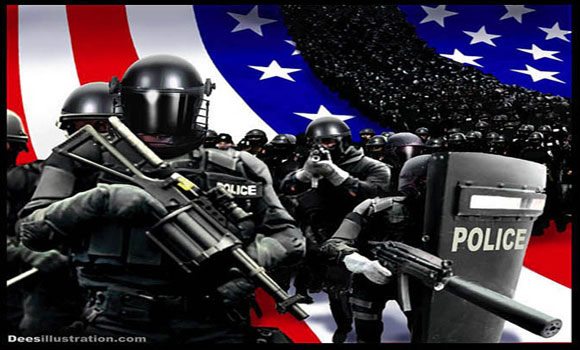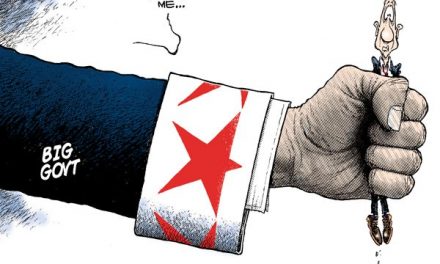
By Lisa Haven
“…the battlefield may no longer be limited to regions afar, but may include the U.S. homeland.”
That is the unnerving quote found in a government study titled Unconventional Operational Concept and the Homeland.
While America may not yet feel like we are living in the middle of a battlefield, we could very well become caught in the coming battle many are projecting for the the near future, at least that is what the Department of Defense wants citizens to believe.
Considering the United States government has been significantly increasing their training preparations with massive military drills like Jade Helm and the stockpiling of ammo, guns, body armor and the like. The possibility of some type of crisis or the declaration of martial law could become a reality a lot sooner than I would like to believe.
Most recently, Majority Leader Mitch McConnell, R-Ky., has made martial law a reality by fast-tracking a broad authorization for the use of military force (AUMF), granting the president unlimited war powers both internationally and domestically. Defense One reported that, “The Authorization for use of Military Force put forward by McConnell would not restrict the presidents use of ground troops, nor have any limits related to time or geography.”
In the report below I delve into all of the above and more! Additionally, I prove we are headed straight for civil unrest, martial law, and an economic collapse….
The Unconventional Operational Concept and the Homeland Report was prepared as part of the Defense Science Board 2007 Summer Study on Challenges to Military Operations in Support of National Interests. It delves into the possibility of a catastrophe or crisis here at home while our military is deployed abroad at war or some other military issue. If that happens then the DOD will be called upon to act here in America. This document ensures preparations for that.
Here are a few important points contained in the report:
Page iii-
“…the battlefield may no longer be limited to regions afar, but may include the U.S. homeland.”
Page vii-
Assuring Deployment and Supply: Three areas seemed most important for DOD attention: (1) critical infrastructure protection and/or resiliency, (2) logistics, and (3) family and individual preparedness. A fourth area, military installation protection and preparedness, was the subject of a recent DSB task force.
Page xiii-
“In the interagency arena, a positive example of how things should work can be found in the Joint Interagency Task Force – South. This pairing of military and civilian government agencies under a unified command structure provides for routine interaction between the entities that will need to work together effectively during a crisis.”
Page xvi-
“Possibly the most neglected member of the homeland security/defense team is the private sector. The private sector owns most of the infrastructure and will be the most effective in protecting (given timely and adequate threat information) and restoring its function after an attack. As such, it must be an integral member of the team alongside government actors in federal planning and information-sharing activities.
“Relationships between sector owners and operators and their federal agency interfaces are uneven—a striking condition that emerged during the course of this study. In some cases, especially where there is a history of a non-regulatory partnership, like the defense industrial base and energy sectors, relationships were positive, characterized by open and frequent communication and information sharing. Others were more one-way, with the federal “partner” more controlling and didactic. The realization that the sectors have more intimate knowledge of not only their own sectors, but their ties to other sectors, has yet to be well understood and embraced at the federal level.”
Page xvi-
“Secretary of Defense leadership in the interagency is needed to address current deficiencies in national plans and strategies and support for domestic threat assessment.”
Page 4-5:
Consequences of Catastrophe, how our America will fall apart:
1. Failure of critical infrastructure- lack of goods and services
2. Insufficient professional resources to deal with multiple catastrophes
3. National Will hard to focus- Public anger manifested through misguided, vigilante-style attacks.
4. Impaired ability of national, state, and local gov to govern- lack of, or confusing, communications, fractured local authority, insufficient, disorganized emergency response. Without adequate preparedness at all levels of government, across the private sector, and among the populace, the post-attack results could indeed become catastrophic.
Some outcomes might include:
– Flight. Remaining in place would prove untenable for many people for actual or perceived reasons.
– Breakdown of mutual aid agreements. Resource-intensive incidents are typically handled through mutual aid agreements within the National Guard, first responder, and medical communities. When under attack, however, leaders in unaffected regions might opt not to support interregional common aid agreements and to conserve their resources in case they are needed locally.
– Breakdown of civil order. Looting, vigilante actions, gang violence, riots, and civil disobedience would further stress first responders.
– Failure of quarantine. Many will be reluctant to stay confined.
– Hoarding. People will rush to amass excess goods to stock up after the attack.
– “Shoot your neighbor.” As people perceive the social and civil situation deteriorating, they will escalate the force they use as a first resort to protect home and family from interlopers (“shoot first, ask questions later”).
– Rampant rumors. Media will promulgate messages from many sources without confirmation.
– Population center “meltdowns.” Many U.S. population centers are located where life without infrastructure services will be difficult to sustain, such as in the desert southwest in summer and northern cities in winter.
Page 10:
“The study found nothing in legislation, directives, or other documents to prevent a moreaggressive posture and engagement by DOD.”
Page 11:
The Posse Comitatus Act is typically viewed as a restriction on DOD engagement since it punishes those who “…except in cases and under circumstances expressly authorized by the Constitution or Act of Congress, willfully use any part of the Army or Air Force as a posse comitatus or otherwise to execute the laws….” A statutory exception to posse comitatus allows the President or other key government officials special authorizations for engaging the military in domestic situations. That authority has been exercised sparingly; examples include granting the U.S. Coast Guard law enforcement authorities and allowing the military to share information and equipment with civilian law enforcement, while prohibiting its ability to make arrests or conduct searches and seizures.
Page 12:
“After the incidents on September 11, 2001, the nation was forced into a new level of national preparedness against attack on the homeland. The Department of Homeland Security was created to take the lead role in homeland security.”
Page 20: Hypothetical scenario and what they will do:
For purposes of this discussion, the study assumed a multi-point attack on the United States that is severe enough for the President to declare the nation “under attack,” with federal authorities in overall control. Under such conditions, national resources will be stretched to the point where demands for national and international requests will go unmet. Local resources will also be overwhelmed and could face societal panic, if people feel localities are unable to provide law and order, medical care, municipal services (water, refuse), food, energy, trade, transportation, information system availability, and protection from the elements. Under such a scenario, two critical warfighting requirements occur simultaneously: defending against domestic catastrophe and ensuring deployment and supply. Domestic catastrophes occur in an environment of a large, undisciplined population, and these violent attacks can have a destabilizing effect on society. On the other hand, military deployment and supply take place in a disciplined organization, trained to accomplish the mission. Yet the two are linked—military deployment and supply is critically dependent on infrastructure elements that may be destroyed or severely compromised in a domestic catastrophe. Furthermore, both missions will draw on many of the same people and equipment, as discussed in the previous chapter. The protection challenge for the U.S infrastructure is significant, as illustrated in Table 5.
Page 32:
“Americans have been conditioned over many decades to assume disaster relief assistance will come from communities adjacent to military installations and that other federal and state assets will be available.
“In the event of coordinated asymmetric attacks in many parts of the country and/or simultaneously with a natural disaster or avian flu pandemic, emergency responders and relief organizations may not be able to move across local or state borders. Resources will be severely strained and responders will be busy dealing with or preparing to deal with disaster on their home turf.”
Page 36:
“According to FEMA, there are over 2,200 Citizens Corp Councils serving areas containing 75 percent of the total U.S. population.”
Page 43- FUSION CENTERS!!!!!!!!!
“Since 9/11 many state and local jurisdictions have established “fusion” centers for the purpose of collecting information on terrorist threats from a wide range of sources—including criminal investigations, the media, and tips from the public.”
“Today 46 states and the District of Columbia have operating fusion centers to create a fuller picture of potential threats in their area.”
Page 44:
“The consensus among these sectors suggested that the GCC/SCC “partnership” concept is good because it provides an opportunity to build trust among all stakeholders.”
For More Information See:
http://usawatchdog.com/next-crash-worse-than-1929-2008-combined-michael-pento/
http://www.infowars.com/breaking-military-martial-law-bill-sneaked-through-by-senate/http://www.defenseone.com/politics/2016/01/senate-leader-surprises-lawmakers-new-isis-war-powers-request/125303/?oref=d-river
http://anonhq.com/pentagon-admits-preparing-mass-civil-unrest-us/
Civil Disturbance Doc (PDF) https://info.publicintelligence.net/USArmy-CivilDisturbances-2014.pdf
http://www.timesunion.com/business/article/Police-stock-up-on-spoils-of-war-5720032.php
http://usawatchdog.com/war-economic-calamity-coming-2016-predictions-gerald-celente/










Lisa very nice report the following is from tldm.org
The Mother of God addressing Veronica Leuken your impressions on this are welcome
Date: November 1, 1985
“My child and My children, the days will grow darker, and there will be hunger in your land. Yes, My child, what I brought you here for this evening is to tell the world that there will be a crash in the monetary doings of your government – an absolute crash that will affect every man, woman, and child in the United States and Canada, and then, like a serpent, creep all over Europe, until the world sees one big, massive depression. I can illustrate to you, My children, what I mean by this monetary depression.
“Should you go and wish to buy a small instrument, even a guitar, that We hear plucking away at the dervishly, and devilry, of what is called the musical Mass, strung by guitars, and other creations of satan. My child, I go on to tell you, you will say that the guitar is not a costly item, but in order to buy this guitar you will carry an actual satchel, an overnight bag – size, My child – let Us put it that way clearly – of notes, your currency. It will take a whole suitcase of paper – paper money that no longer has a value. You will soon be reduced to bartering for your food.